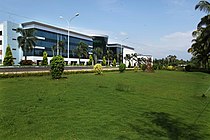
Back منطقة الابوزها Arabic الابوزها ARZ अलाप्पुझा जिला Bihari আলেপ্পি জেলা Bengali/Bangla Alappuzha (distrito sa Indiya) CEB Alappuzha (Distrikt) German Distrito de Alappuzha Spanish Alappuzha barrutia Basque بخش آلاپوژا Persian District d'Alappuzha French
Alappuzha district
Alleppey district | |
|---|---|
|
Clockwise from top: Kettuvallam, Thottappally, Alappuzha Beach, Infopark Campus, Cherthala, Alappuzha Bypass, and Krishnapuram Palace at Kayamkulam. | |
| Nickname: | |
 Location in Kerala | |
| Coordinates: 9°29′N 76°29′E / 9.49°N 76.49°E | |
| Country | |
| State | Kerala |
| Headquarters | Alappuzha |
| Government | |
| • District Collector | Alex Varghese, IAS |
| • District Police Chief | MP Mohanachandran IPS [2] |
| Area | |
• Total | 1,414 km2 (546 sq mi) |
| • Rank | 14th |
| Population (2011) | |
• Total | 2,127,789 |
| • Density | 1,500/km2 (3,900/sq mi) |
| Languages | |
| • Official | Malayalam, English |
| Time zone | UTC+5:30 (IST) |
| ISO 3166 code | IN-KL |
| Vehicle registration | KL-04 Alappuzha, KL-29 Kayamkulam, KL-30 Chengannur, KL-31 Mavelikara, KL-32 Cherthala, KL-66 Kuttanad |
| HDI (2005) | |
| Website | alappuzha.nic.in |
Alappuzha district (Malayalam: [ɐːlɐpːuɻɐ] ⓘ), is one of the 14 districts in the Indian state of Kerala. It was formed as Alleppey district on 17 August 1957, the name of the district being changed to Alappuzha in 1990.[5] Alappuzha is the smallest district of Kerala.[6] Alleppey town, the district headquarters, was renamed Alappuzha in 2012.
A town with canals, backwaters, beaches, and lagoons, Alappuzha was described by George Curzon, the British Governor-General of India in the beginning of the 20th century CE, as the "Venice of the Eastern world."[1] The district is best known for its picturesque Kerala Backwaters, by which it is well connected to other parts of Kerala, including the tourist destination of Kumarakom, the district being a well known tourist destination in India. It is also known for its coir factories, as most of Kerala's coir industries are situated in and around the Alappuzha town.
The Vembanad lake, which lies below the sea level, is the longest lake in the Indian peninsula, and the district of Alappuzha lies between this lake and the Arabian Sea.[7] Kuttanad region of the Alappuzha district, which lies below the sea level, is the point of least elevation in the entire India.[7] Kuttanad, also known as The Rice Bowl of Kerala, has the lowest altitude in India, and is also one of the few places in the world where cultivation takes place below sea level.[8][9]
The district was home to the Communist-led Punnapra-Vayalar uprising against the Divan of the British Princely state of Travancore in the 1940s.[10]
- ^ a b "History | District Alappuzha, Government of Kerala | India". Retrieved 8 September 2020.
- ^ "Home". Alappuzha District. Retrieved 21 February 2021.
- ^ "District Profile". Government of Kerala: Alappuzha. 2018. Archived from the original on 12 June 2018. Retrieved 11 June 2018.
- ^ "Kerala | UNDP in India". UNDP.
- ^ "History". Government of Kerala: Alappuzha. 2018. Archived from the original on 12 June 2018. Retrieved 11 June 2018.
- ^ "District Profile". Kerala State Planning Board – District Planning Office, Alappuzha. 2015. Archived from the original on 17 February 2020. Retrieved 9 March 2020.
- ^ a b Cite error: The named reference
Mathrubhumiwas invoked but never defined (see the help page). - ^ "Kerala Boat Ferries Lone Passenger To Help Her Take Exam". NDTV. Press Trust of India. 1 June 2020. Retrieved 17 November 2020.
- ^ Suchitra, M (13 August 2003). "Thirst below sea level". The Hindu. Archived from the original on 22 September 2019. Retrieved 17 November 2020.
- ^ Manorama Yearbook 2011, ISSN 0970-9096






